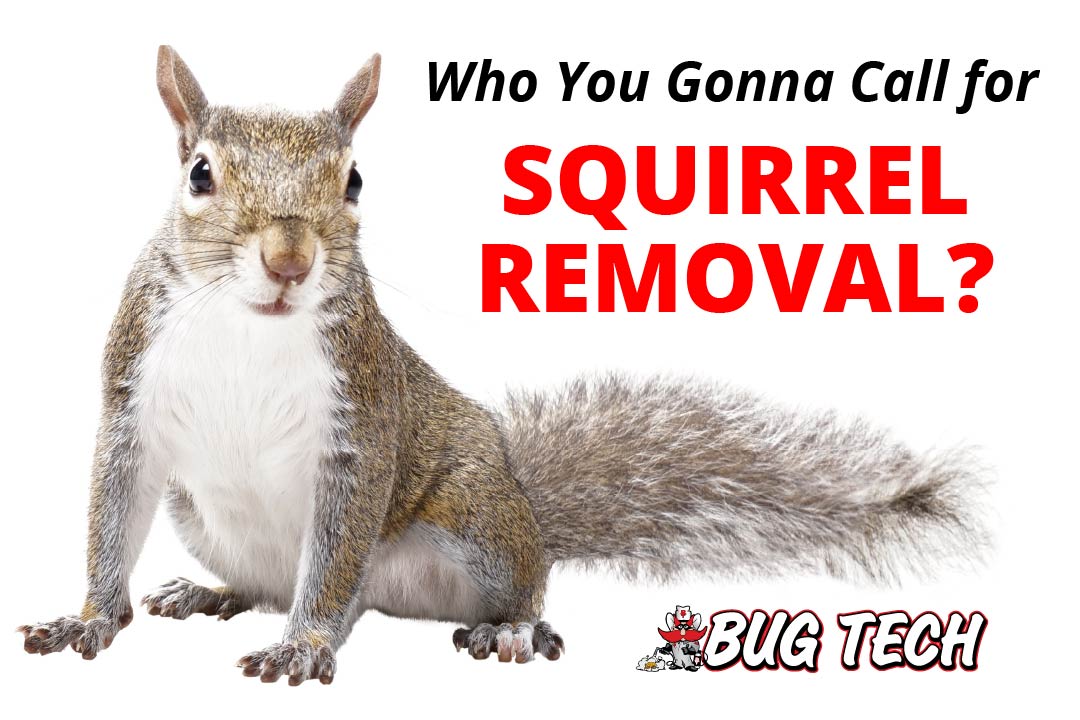Who to Call for Squirrel Removal?

It’s common to see squirrels roaming around in yards or climbing trees. However, many consider them pests since they can wreak havoc on plants and trees. Further, they can find ways to enter your home, consume food and cause damage to your property.
You can rely on Bug Tech specialists to provide reliable wildlife removal in Lubbock and Amarillo. Our team has extensive experience removing squirrels safely and humanely.
Licensed and Trained National Wildlife Control Operators

As a National Wildlife Control Operators Association member, Bug Tech has the experience, licensure, certification, and expertise to safely and effectively remove wildlife threats from your home or property. It's important to remember that any wildlife removal, including squirrels, can be dangerous if not done properly, and it's best to leave it to professionals like Bug Tech who have the necessary training and equipment to handle the situation safely.
Additionally, our squirrel removal services can ensure that the animals are removed humanely and released back into the wild. If you have a squirrel problem on your property, it's best to contact a professional wildlife removal service like Bug Tech to assess the situation and provide safe and effective removal solutions.
Places That Squirrels Frequent
There are around 200 squirrel species around the world. However, red and gray squirrels are the most common species found in Texas with gray species being the more common variant that you can find in most states. Gray squirrels are more tolerant of humans and can thrive in urban and suburban areas. If you live in neighborhoods with plenty of oak, balsam fir, pine, and spruce trees, you’re bound to find squirrels in your community.
Like all wildlife, squirrels usually stay where there’s a food source. Their food staple foods include walnuts, beechnuts, hickory nuts and acorns. They feast on seeds, flowers, buds, grains and fruits. Since they’re opportunistic creatures, expect these critters to enter your home in search of food when an opening is available.

It's important to note that all of these squirrel species are protected by Texas state law, and it is illegal to kill or relocate them without a permit. If you have a squirrel problem on your property, it's best to contact a licensed wildlife removal service for assistance.
Common Squirrel Species
You can find several species of squirrel in the country, and their distribution varies from one state to another. Several factors influence their presence in different regions, including the available habitat, local conditions and the climate.
Here are some of the squirrel species you may find in your surroundings:
Eastern Gray Squirrel (Sciurus carolinensis): This is the most common type of squirrel across all states. They’re the most widespread squirrel species in North America, and these may be the ones you frequently spot on your property. You can find them in suburban neighborhoods, parks and other wooded areas.
Eastern Gray Squirrels typically grow to be around 18 inches (45 cm) long, including their bushy tails. They can weigh up to 1-2 pounds (0.5-1 kg). They have gray or brownish-gray fur on their backs, with a white underbelly. Their tails are long and bushy, and they have small, rounded ears. Eastern Gray Squirrels are primarily herbivores and eat a variety of nuts, seeds, fruits, and berries. They will also eat insects, bird eggs, and small animals on occasion.
Habitat: Eastern Gray Squirrels live in a variety of habitats, including forests, parks, and urban and suburban areas. They are active during the day and are known for their acrobatic abilities, including their ability to jump from tree to tree. They build nests, called dreys, out of twigs and leaves in the branches of trees.
Fox Squirrel (Sciurus niger): This is the squirrel species that can easily be found in much of the central U.S., including Lubbock and the Texas Panhandle. Fox squirrels are larger than Eastern gray squirrels, typically growing to be around 20-27 inches (50-70 cm) in length, including their bushy tails. They can weigh up to 1.5-2.5 pounds (0.7-1.1 kg).
Fox squirrels have distinctive reddish-brown fur with a white underbelly. They also have long, bushy tails and large, pointed ears. Fox squirrels are omnivores and eat a wide variety of foods, including nuts, seeds, fruits, insects, and small animals. Fox squirrels are found in a variety of habitats, including woodlands and urban areas. Like other squirrel species, Fox squirrels are active during the day and are known for their agility and acrobatic abilities. They build nests, called dreys, out of leaves and twigs in suburban neighborhoods.
Signs of a Squirrel Infestation
Squirrels can quickly become a nuisance when they start invading your home. An infestation can pose health risks and damage to your belongings. Further, they can be challenging to eliminate when their numbers have grown. For this reason, homeowners should know who to call for squirrel removal services.

Here are some of the crucial signs of an infestation you should look out for:
- Squirrel Sightings: Seeing one or two squirrels on your property is alright, and they usually don’t cause any harm. However, notice their numbers rising, and you will see them more often within your yard or even on your roof. That may be an indicator of an infestation.
- Nests: Just like some animals in the wild, squirrels also build nests to provide warmth and protection from the elements. They use twigs and other available materials they can find. However, suppose you find these nests in your home's chimneys, attics, basements and other parts. In that case, hiring a professional squirrel removal service is best.
- Gnaw Marks: Like most pests, squirrels love to chew and gnaw on things. They can gnaw on plastic pipes, electrical wires, wooden structures and almost anything in your house.
- Droppings: You can usually find squirrel droppings in places where they feed. They look like tiny pellets shaped like a cylinder that has a black or brown color. They’re generally around a quarter to a half-inch in length. You can find it near the trees they frequent, the ground outside your home and where they have infested, such as attics and other crawlspaces. Droppings can carry diseases, so it is crucial to handle them carefully.
- Damage to Your Home: Other than holes in food packets and containers, squirrels can cause a lot of damage to your property. They particularly love to chew on electrical wires, which can cause a fire hazard. You can also find them chewing on your home’s insulation and wooden structures.
- Strange Noises: Squirrels can be quite active even when they’re inside your home. Often, they will make noises when they run around and look for food.
Should I DIY Squirrel Removal?
Some homeowners may consider using DIY measures to remove squirrels from their property. They may think that hiring a professional wildlife removal company can be too costly. Here are some of the pros and cons of using DIY methods to eliminate a squirrel infestation.
Pros
- Cost-Effective: You may save money when you try to remove squirrels from your home on your own. You can buy traps, lay them yourself and humanely transport the squirrels away from your property.
- Immediate Response: You don’t have to wait for the professionals to become available. You can immediately act as soon as you notice the signs of a squirrel infestation.
- Process Control: When you DIY the squirrel removal process, you can customize the solutions according to your needs. You can choose more humane ways to remove these critters from your home instead of using poison and other chemical solutions used by exterminators.
Cons
- Safety Concerns: Squirrels can get aggressive, and they are known to attack humans that confront them. There is a risk that you can get injured when you try to capture squirrels on your property.
- Legal Issues: In some places, it is illegal to trap squirrels if you don’t have a permit. You may have to secure one to avoid any legal consequences.
- Lack of Experience and Expertise: Many homeowners aren’t trained or are ill-equipped to handle a squirrel infestation. You may waste money on equipment and supplies while yielding very minimal results.
Squirrel removal requires careful consideration, so please consider the pros and cons before tackling the issue on your own. In many instances, hiring professional pest control experts is often best, which saves you money in the long run.
Who to Call for Squirrel Removal?
Dealing with a squirrel infestation can be challenging. Our professionals at Bug Tech will work closely with you to address your situation efficiently. When you work with our team, you leverage our expertise and experience. We have proudly served Lubbock and Amarillo since 2010, offering humane pest control services you can rely on.
Here’s what you can expect when you work with our experts:
- Site Inspection: We thoroughly inspect your home, identifying the squirrel species and the extent of the infestation.
- Removal: Our team uses humane integrated pest management solutions using mechanical, cultural, chemical and biological techniques to effectively remove pests from your property.
- Exclusion: We also seal off any entryways so squirrels won’t be able to re-enter your home again.
- Cleanup: Part of our process includes cleaning up and repairing any damage squirrels may have caused. This includes patching up any holes and sealing off broken pipes and other entry points.
- Prevention: We also provide advice and preventive measures to prevent further infestations.
At Bug Tech, we know many homeowners may wonder who to call for squirrel removal. We provide our clients with effective and reliable solutions customized to their needs. In addition, we offer a free estimate with every consultation, and customers can start with a free inspection of their premises so they can understand our approach.
